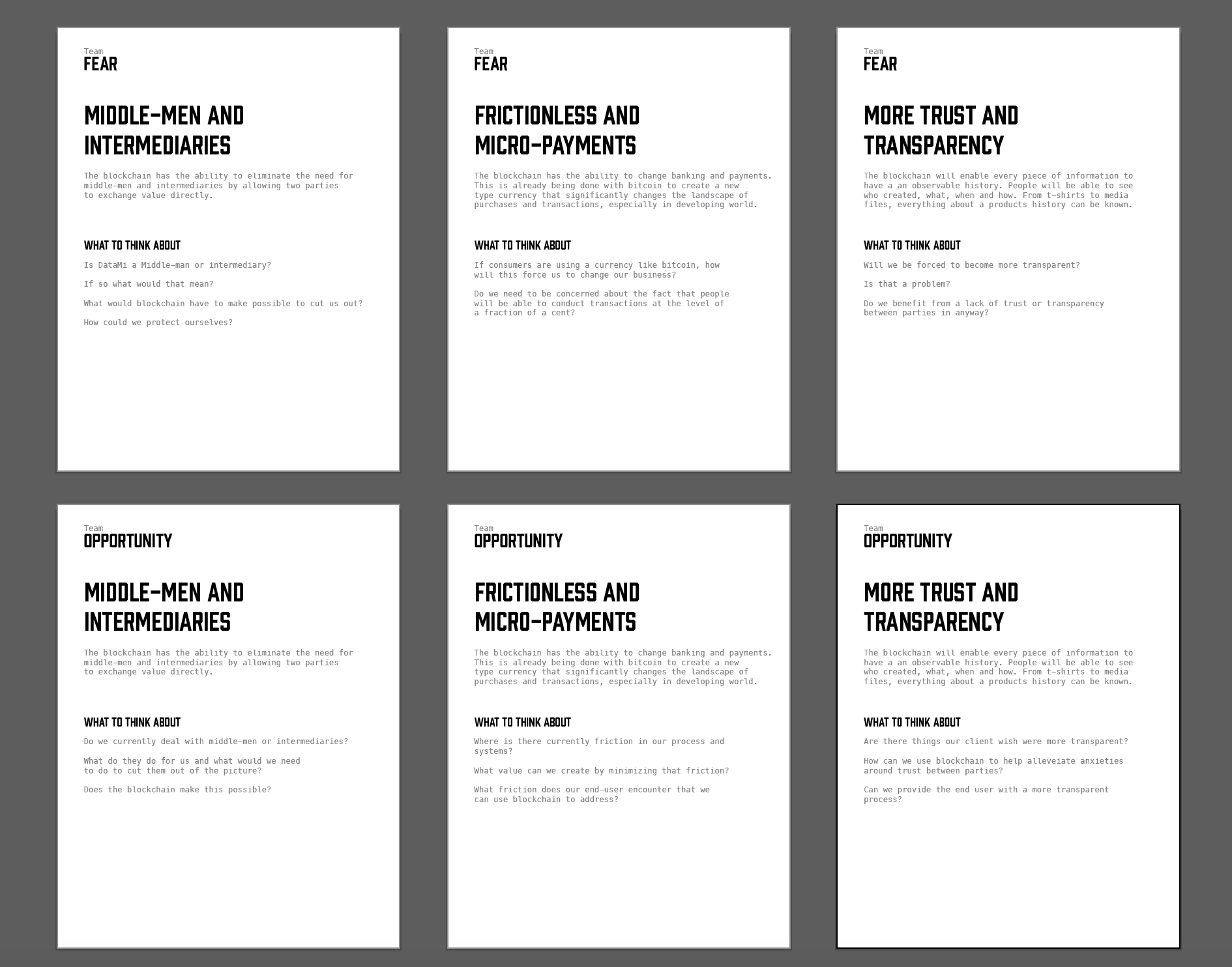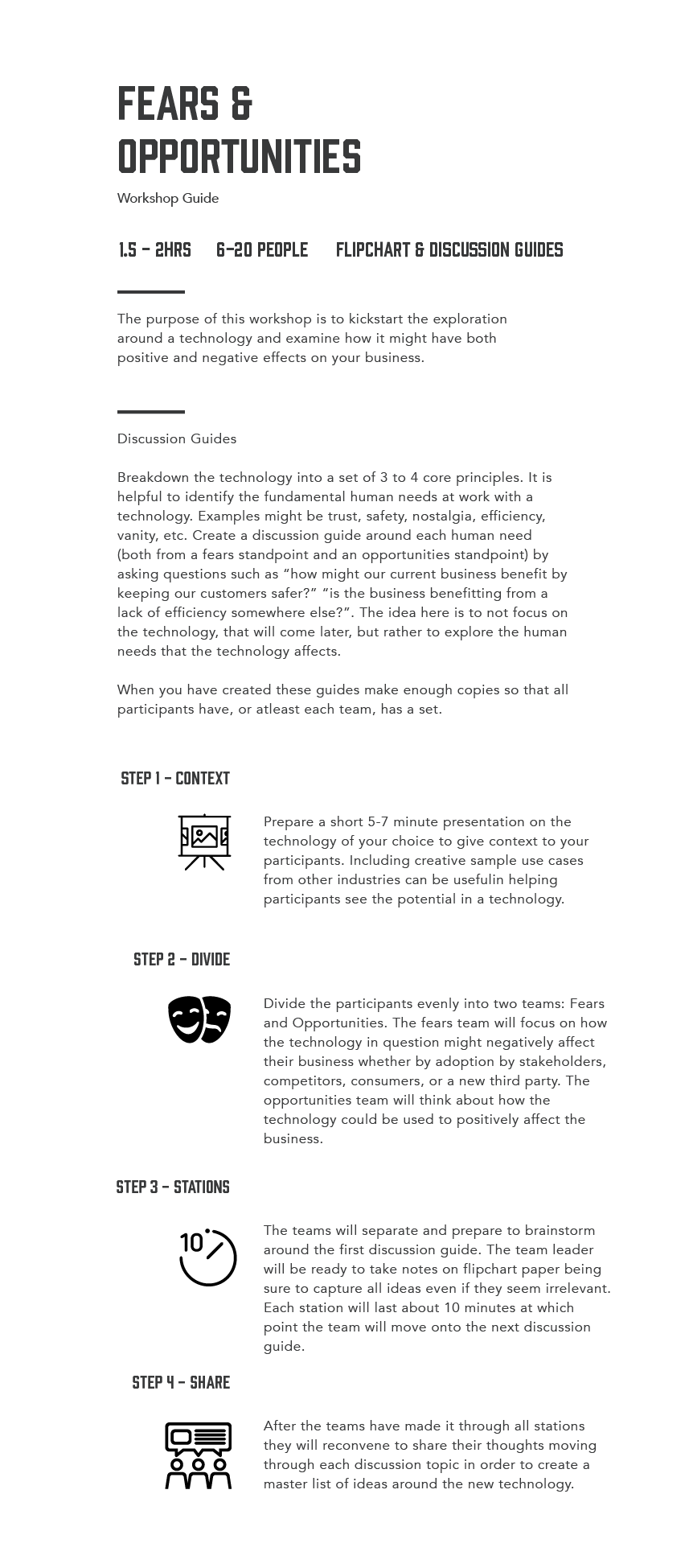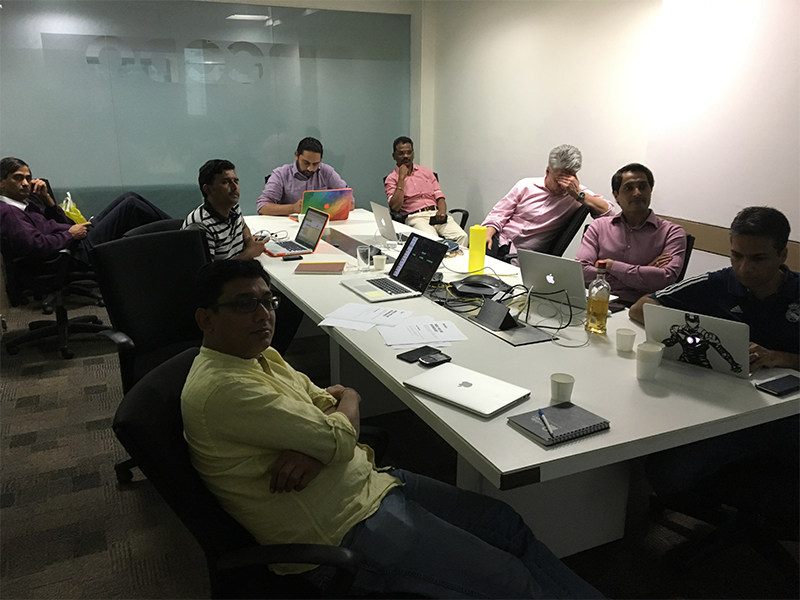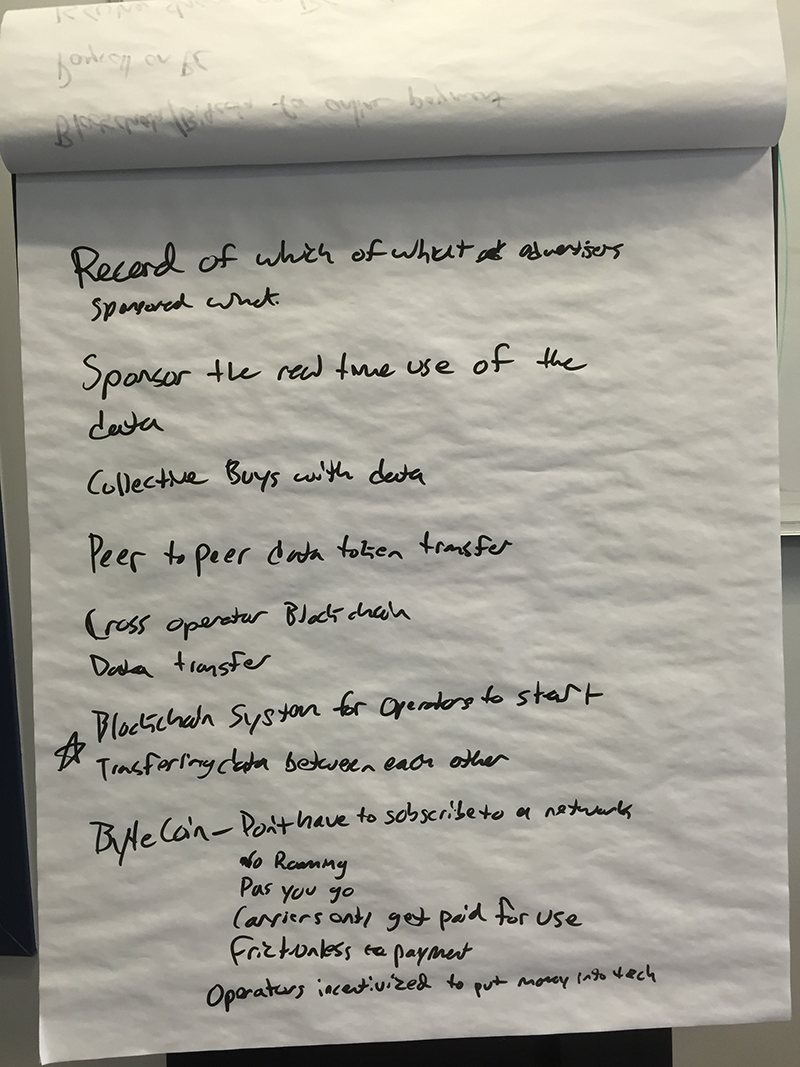DEFINE
The definition phase of my time at Datami was focused on reconciling my knowledge of ad tech with blockchain to identify key opportunity areas that were relevant to the business. To do this, I conducted a brainstorming workshop with members of the company to gather insights, perspectives and ideas. In addition to opportunity areas I identified on my own, the workshop provided me a number of directions that Datami might be interested in exploring. Out of these options, I conducted further research on 4 areas and presented these opportunity areas to the leadership of Datami where we decided on a single opportunity area to pursue.
Fears & Opportunities Workshop
To uncover knowledge about the problems and concerns professionals in the advertising technology space encounter and to begin honing in on a narrower set of potential solutions, I designed a workshop to run with my company. I was encouraged by the interview I conducted with Eva Schon from Consensys where she explained to me how valuable design thinking and designers are at the early stages of hackathons (Schon, 2016). This is because it is designers who are uniquely equipped to communicate in the face complexity. This thought serves as a firm signpost in favor of validating some of my earlier assumptions around the role a designer can play in these types of highly complex fields. The workshop came in the form of a brief presentation at the start of the session followed by a guided brainstorming exercise. There were a total of 16 participants, 5 were in the office with me in Boston and rest were being led by a teammate, Emma, in India. Coming into this phase of the research, it was important to adhere to a human-centered methodology. This meant accepting the possibility that blockchain might not solve a problem for Datami. I thought this to be a highly unlikely outcome, but nevertheless a possibility. In the event that this was the case, I also wanted to make sure that Datami was aware of other external systems or businesses that could change and subsequently affect Datami’s business as a result of adopting blockchain. I relayed this to the participants as I thought it would be useful to them to have some context as to why they were doing what they were doing. The short presentation that I gave at the top of the session described blockchain and its potential at a very high level and also included some novel use cases that are already being explored in other industries. Blockchain consultant Scott Akers agreed with this approach in an interview I conducted with him. When speaking on how to overcome the complexities of communicating blockchain Scott reccomends,
"Finding natural analog and parallels is a very key point in communicating this technology. Really just grounding it in people’s every day occurrence and understanding of how the world works (Akers, 2016)."
To explore both the opportunities to leverage blockchain and the effects it might have on the business from external sources, I divided the workshop into halves. One half of the participants would evaluate threats to the business and the other half would be examining opportunities. This is similar to the quadrants used in SWOT analysis (Strengths, Weaknesses, Opportunities, Threats) (Morrison, 2014).


As mentioned before, there are a few key features of blockchain technology that are rooted closely to human experience. I chose 3 of these areas that, given the research on both ad tech and blockchain that I had conducted so far, seemed the most relevant. These 3 areas were trust and transparency, frictionless and micropayments, and middlemen and intermediaries. I created brief discussion guides for each station, on both the fears side and the opportunities side, that included some initial questions to get conversations started. The teams then proceeded to spend 10 to 15 minutes brainstorming and discussing the subjects in question while Emma and I captured thoughts and ideas on flip-chart paper for our respective teams. Because the workshop was divided geographically, we decided to have the teams check in with each other via Skype after each round to monitor progress. After all the brainstorming sessions were complete, the teams shared their notable findings.


Feedback
The participants of the workshop were developers, programmers, and engineers and they were either somewhat familiar with blockchain already or had the requisite foundation of knowledge to understand it quickly. I thought that this might have had been a problem as I wanted to avoid getting stuck in discussions around practicality, feasibility, or the technical aspects of blockchain. This risk was successfully mitigated by not focusing directly on blockchain but more on its underlying fundamental values. Given the amount of ideas and interest that emerged in the workshop, it was clear that blockchain was immensely relevant to the advertising technology industry and that the design of the workshop had been successful in eliciting those ideas.
I conducted a series of feedback interviews on the efficacy of the workshop to identify what was working and what wasn't. Robin told me that he definitely thought the workshop was valuable and this was due to the quality of the ideas that came out the workshop. Robin believes the ideas that we came up with were "amazing" which is great feedback to say the least. When speaking of the learnings that the workshop provided, Robin said,
"My understanding about blockchain and how this whole ecosystem works - I basically learned alot from that. And it was a good 1 hour to 2 hour session where we could be creative and think out of the box (Balyan, 2016)".
Robin went on to say that he believes that all companies should be running workshops like the one we ran. Mahender felt mostly the same way about the workshop telling me that it was a good way to flesh out ideas around technologies and explore what makes sense for the business. When talking to Mahender about iterating on the worskshop, he believes that the workshop would work for any company and that you need to keep the workshops going to continually build on the ideas (Korandla, 2016). Minyan also enjoyed the workshop and said that coming in she did not know much about blockchain, but by the end of it she was surprised at the level of ideas that had been produced. She also believes that Datami should continue running workshops of this sort. Minyan went on to say that the piece of the workshop that she felt was particularly valuable was the presentation of other use cases for blockchain.
"We thought of something that could totally change the industry (Shi, 2016)."
In speaking with the CTO, Jagan Shanitgram, about the workshop I was interested in getting the point of view of someone who manages the development of technologies and the teams that work on them. If this process of exploring technology is to be successful than it will certainly need the buy-in from such key stakeholders as the CTO. In reflecting on the Fears and Opportunities workshop Jagan had this to say,
"I think it was very effective. It was something that was really good. There were two pieces of learning for me, one of course was blockchain itself. The other piece was the process and I think that process can definitely be something we can leverage going forward just to sort of jumpstart creative problem solving (Shantigram, 2016)."


The "Fears" Team in India being led by Emma
Reflection
Going into the workshop, I had serious apprehensions about its efficacy. This was due largely to the fact that it had taken me weeks, maybe even months, to fully grasp blockchain and I was going to need to communicate it succinctly and explore its potential within the span of a couple of hours. Furthermore, I was the newest member of the company, and the one with the least experience in how the company or the industry in general worked. On one hand, this was unsettling but on the other, it was the exact reason for which I was conducting the workshop in the first place. Going through this workshop helped me to realize that just because you are the one standing, leading, talking, and facilitating, it doesn’t mean that you are teaching. I made a point to be very clear that I was not the expert in the room and that I was there to learn. From a facilitatory perspective, I think this helped to address the power dynamic in the room and give the participants confidence in brainstorming. The workshop also helped me to realize the role of the designer as translator as it became clear that one of the key benefits a designer can offer a company is the ability to take these technologies that aren’t yet understood by the rest of the organization, unpack them, and repackage them in a way that makes sense for the given context. Designers do this all the time with consumer facing products by repackaging what a company does into a brand and a vision, but in this case those skills also proved useful.
As well as this workshop went, it could be improved. As mentioned before, the opportunities team significantly out performed the fears team in idea generation. This highlights something very important and central to design. The difference between the teams that caused this to happen, I believe, is empathy. The opportunities team benefitted from having knowledge of their own company and being quite familiar with their pain points and the pain points of the end users that Datami serves. In contrast, the fears team was largely brainstorming around how other organizations might disrupt Datami and given the nature of blockchain (highly technical, b2b/systems/infrastructure oriented), I believe this is a much harder task. Blockchain has the power to get rid of middle men, or bring transparency to business dealings. In a blockchain future, a company's current collaborators or stakeholders could be their disruptors. Because of this, participants would need intimate knowledge of the systems and processes of other stakeholders' business to truly effective in imagining how they might disrupt Datami. Bringing this back to design in general, it highlights the difficulty for designers to be effective in b2b/systems level contexts. A designer has a reasonable amount of empathy for any number of consumer behaviors such as shopping, sharing media, or sending messages. However, a designer is starting from almost perfect ignorance when trying to design for a highly technical or specific role that another person has spent years working to perfect. To improve the efficacy of this workshop method, one might consider the technology at hand, and if it is a highly technical one like blockchain, the workshop might be better ran as a strengths and weaknesses workshop. In this version of the workshop, teams would explore how the technology could fortify their core competencies and address their weak points.
Opportunity Areas
With a large body of research behind me, I was able to begin narrowing my focus, the goal being to have a shortlist of directions which I could present to the company leadership and then to choose a single area for which I would produce a prototype. The process of this included taking all of the ideas (both my own, and those from the workshop) and clustering them into groups of related ideas. Additionally, to ensure a diversity of options, I gave each cluster a time horizon based on my research to indicate how long it would be before an idea in a given area was ready to be executed given market factors. I aimed to spread the opportunity areas across a temporal perspective ranging from currently relevant to far future possibility. The four opportunity areas are as follows: Bytecoin, Mobile Ad Attribution, Programmatic Buying, and Sponsored banking.
Feedback
I presented these four directions to the CEO, CTO, CMO, and Head of Product. Feedback on the directions were positive but there was not a clear consensus on which direction to pursue. Sitting down with the CEO, we decided that the sponsored banking direction was ultimately the best choice as it was the most tangible and applicable to the current business meaning also that it would be the most easily prototype-able. Furthermore, the a sponsored banking solution would be solving a user need in a more traditional design sense. The other areas would be design solutions that would solve issues in a B2B context as opposed to B2C.
In evaluating the opportunity areas as the collective product of the workshop session Jagan Shantigram (CTO) said,
"I think for the workshop these are great ideas (Shantigram, 2016)."
Expanding on the workshop futher, Jagan had feedback for me around the selection and evaluation of technologies. Jagan reccomended a litmus test of whether or not any of these ideas disrupt the idea of a centralized information database.



















